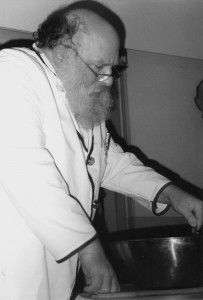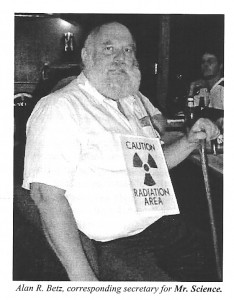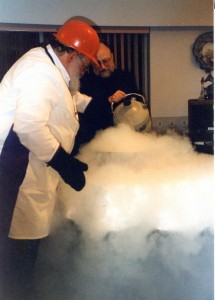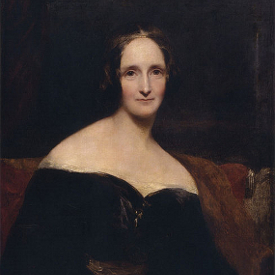 1974. VCON 3. I’m sitting in a hotel ballroom listening to Ed Hutchings lecture on the Movie Metropolis. Movement in a balcony. I glance up.
1974. VCON 3. I’m sitting in a hotel ballroom listening to Ed Hutchings lecture on the Movie Metropolis. Movement in a balcony. I glance up.
Great thundering Ghu! Santa Claus with a shotgun!
Once I got over my shock I realized it was just a large bearded man wielding a shotgun mike as he strove to capture the lecture on audio tape (preserved in the BC SF Association archive).
This was my introduction to Alan R. Betz aka ‘Mr. Science’, a man of intense, even intimidating gravitas. Long ago BCSFA participated in a science fiction ‘day’ at the Vancouver Science World Museum. The club table was manned by Al Betz. He sat arms folded, of fierce mien, staring into space. He resembled a particularly truculent ‘hanging’ judge. Oddly enough, nobody approached the table.
 So no surprise it took me a while to realize behind Al’s stern façade lurked a gentle soul devoted to everything radioactive, passionate about old media SF, and brimming with a sparkling sense of humour. He was, by default, the much beloved curmudgeon mascot of BCSFA, popular throughout Western Canada and the Pacific Northwest. Alas, he passed away in April of 2011 but lives on in the fond memories of all who knew him.
So no surprise it took me a while to realize behind Al’s stern façade lurked a gentle soul devoted to everything radioactive, passionate about old media SF, and brimming with a sparkling sense of humour. He was, by default, the much beloved curmudgeon mascot of BCSFA, popular throughout Western Canada and the Pacific Northwest. Alas, he passed away in April of 2011 but lives on in the fond memories of all who knew him.
Born in San Francisco in 1939, his education (in his own words) “…did not take place entirely in schools. Many experiments were performed, some of which did not result in explosions. The radioactive fallout I generated was successfully concealed by the atmospheric testing of the period.”
Al came to Canada in 1968. He joined the British Columbia SF Association in 1973 and promptly became electronic archivist, taping VCON panels on reel-to-reel tape and, by 1978, filming VCONS with video cameras.
As Mr. Science he performed experiments at conventions like VCON, MOSCON, and BANFFCON, only occasionally involving massive radiation leakage and/or enormous explosions.
Perhaps his greatest triumph was his VCON 16 radiation blast experiment in 1988. Using long metal prongs to transfer a radioactive capsule from a lead-lined box to a table, he warned the audience in the first two rows to move back lest they be rendered sterile by excessive exposure to gamma rays. An outraged woman shot up from her chair, yelling:
 “How dare you expose us to danger! How dare you! There are children present! You want them to mutate?! How dare you call yourself a scientist! You’re a monster!”
“How dare you expose us to danger! How dare you! There are children present! You want them to mutate?! How dare you call yourself a scientist! You’re a monster!”
![]()
 Mr. Science was very, very pleased. A subsequent explosion (See photo. Achieved with flash powder? Magnesium?) did little to calm the woman’s nerves. Overall the experiment was a success. Everyone survived. Few mutated. However, the experiment did go slightly awry in that it forced Mr. Science to judge next day’s Mr. Science Beauty Pageant from the point of view of a disembodied brain floating in a jar.
Mr. Science was very, very pleased. A subsequent explosion (See photo. Achieved with flash powder? Magnesium?) did little to calm the woman’s nerves. Overall the experiment was a success. Everyone survived. Few mutated. However, the experiment did go slightly awry in that it forced Mr. Science to judge next day’s Mr. Science Beauty Pageant from the point of view of a disembodied brain floating in a jar.
Tragically, Mr. Science was greatly saddened when a police bomb squad dealt with a radioactive package, found on the side of the road a block from where he lived, without even bothering to consult him. News footage would have been enlivened by his Zeus-like presence in a solar-powered propeller hard hat and resplendent white science coat featuring shiny purple isotope buttons. A splendid opportunity missed.
Without doubt his most popular experiment, frequently performed, was liquid nitrogen ice cream. Not for the faint of heart.
I recall going with him to purchase a cylinder of liquid nitrogen. He had me sit in the back seat of his car with the cylinder standing upright on the floor, my knees and hands holding it secure. I couldn’t help but notice the cylinder was venting.
“Let me know if it tips over,” said Al as we drove off. “I’ll stop the car. We’ll have about ten seconds to escape.”
“Escape from what?”
“The liquid nitrogen. Spilling out, it’ll turn into gas, its volume displacing all the air in my car. There’ll be no oxygen. We’ll suffocate.”
I clung to the cylinder, grimly determined to keep it secure, and equally determined, should the cylinder topple, to jump out of the car even before Al could bring it to a halt. I also practised holding my breath. A lot.
 Ah, nitrogen ice cream. One photo shows Clint Budd pouring the liquid into a sturdy metal bowl as Al supervises. Another shows Al bravely taking the temperature of the resulting mix (on a different occasion). It is very important to stir quickly (using a wooden spoon if my memory is correct) as the ingredients tend to harden to a rock-like consistency very quickly. Even more important (given that liquid nitrogen is about a gazillion degrees below freezing) is to wait till the resulting ice cream warms enough to allow you to put it in your mouth without fatal results. Mr. Science placed great emphasis on this.
Ah, nitrogen ice cream. One photo shows Clint Budd pouring the liquid into a sturdy metal bowl as Al supervises. Another shows Al bravely taking the temperature of the resulting mix (on a different occasion). It is very important to stir quickly (using a wooden spoon if my memory is correct) as the ingredients tend to harden to a rock-like consistency very quickly. Even more important (given that liquid nitrogen is about a gazillion degrees below freezing) is to wait till the resulting ice cream warms enough to allow you to put it in your mouth without fatal results. Mr. Science placed great emphasis on this.
The ingredients? 1 litre heavy whipping cream; 1 litre half-and-half; 450 ml. granulated sugar; 3 whole eggs; 75 ml. vanilla extract; flavouring, as desired; 5 litres liquid nitrogen.
Thing is, you should not try this at home. It requires training in the use of liquid nitrogen and specific knowledge of the proper precautions to take. Not for amateurs. Too dangerous.
But you should have seen the lineups! Every congoer wanted a spoonful. Tasted good too.
Renowned for his educated sense of humour, Al won an Aurora Award in 1991 for his “Ask Mr. Science!” column which first appeared in the July 1987 issue of ‘BCSFAzine’ and went on to appear in the ‘Ottawa SF Statement’ and ‘On Spec’ as well.
It is with immense gratitude I note that Mr. Science gave me, his willing acolyte, his blessing to write my “Ask Mr. Guess-It-All!” columns in homage to his own writing which illness had caused him to suspend. I append several examples of his joyous scientific humour:
< — >
Ms. LB, of Burnaby, B.C., asks:
WHY IS THE SKY BLUE?
Mr. Science: The present colour of the sky is caused by an accumulation of the traces of blue aniline dyes produced by the burning of tobacco in cigarettes. As the foul habit of cigarette smoking is stamped out, and photo-destruction of these insidious dyes takes place in the upper atmosphere, the sky will slowly return to its normal, beautiful salmon pink colour.
< — >
Mrs. KB, of Port McNeil, B.C., asks:
CAN THE OZONE LAYER BE SAVED?
Mr. Science: Certainly. If 500 very large nuclear-powered Tesla coils are taken to the upper altitude limit of heavy lifting balloons, enough ozone can be generated to replenish the ozone layer in a matter of several weeks.
< — >
Ms. DM, of North Vancouver, B.C. asks:
WHY ARE ROCKS SO HARD?
Mr. Science: Although they may appear to be inanimate objects, rocks are in reality very slow moving, rather unintelligent animals with very thick skins. Because they move so slowly they have developed some interesting defense mechanisms. First, rocks do not taste good and most creatures that try eating one do not repeat the experiment. Second, rocks do not like to be sat upon. If you sit on one it will become tense, its skin getting harder and harder until you finally have to move. By the way, when rocks are in a hurry they simply crawl into streams where the water acts as a lubricant, allowing them to slide along the ground more quickly.
< — >
Ms. SB, of Coquitlam, B.C., asks:
WHY DID THE TITANIC SINK?
Mr. Science: Although it was kept secret from the passengers, crew and public, the Titanic was engaged in a metallurgical testing program aimed at finding a new alloy for rivets. One large hull plate was fastened in place with rivets made of a sodium/steel alloy which had been formulated incorrectly by a dyslexic chemist who reversed the intended proportions of 3% sodium and 97% iron. The sodium remained reactive, and slowly dissolved in the cold seawater. When the plate fell away, the ‘unsinkable’ Titanic went down.
< — >
Mr. HW, Jr., of Hagerstown, MD, asks:
WHERE DOES THE WATER FROM MY AUTOMATIC DEFROSTING REFRIGERATOR GO?
Mr. Science: If you own a General Electrical, Westinghome or Hotspot unit with the letter “X” in its model number, YOU ARE IN GRAVE DANGER! These are experimental models which dispose of the water produced during automatic defrost by electrolysis. The oxygen produced by this process is simply vented to the air and poses no hazard. But the hydrogen is absorbed into two large palladium rods inside the system. Under certain conditions heavy hydrogen (deuterium), present to the extent of one part in six thousand of normal hydrogen, may accumulate to the point where “cold” fusion will result in a rather large melt-down of your kitchen.











The BCSFA archive has a copy of the collected works of Mr. Science, a booklet gestetnered by Steve Forty for distribution at Westercon 44/VCON 19.
Subsequent Q&A columns can be found in the pages of various BCSFAzines printed after that convention.
I will scan the ‘Ask Mr. Science’ booklet this weekend and post it on my http://www.cdnsfzinearchive.org web site.
Eventually hope to post all the later columns as well once I track them down.
Perhaps I’ll prepare a zine in homage to Mr. Science with ALL of his columns, plus as many photos as I can find.
I did make a start on a lengthy bio of his fannish career but a computer crash destroyed the article (no backup!) and I haven’t had the energy to begin again. The research involved, among other things, reading every BCSFAzine from the time he first joined in 1973 to the time he passed away in 2011, looking for articles and info by and about him. A book-sized project actually. Maybe I’ll try again someday.
At any rate, I was one of those present at your home when Al prepared the ice cream. A great event that was. Fond memories.
Thanks Graeme for including that photo of Mr. Science making his ice cream. That particular instance was in my TV Room many years ago. I have fond memories of the pomp and circumstance involved in the making; the science behind the making and the fact that we had to wait dang near an hour before the ice cream had warmed up enough for us to actually attempt to get a spoon into it!
I miss the Mr. Science columns in BCSFAzine, and believe that S40 holds all the Ask Mr. Science articles. Would love to see those gathered into a book.
There were 5 Mr. Science Q&A attached to the main text. They didn’t go in. Some sort of glitch. Will attempt to resolve.
Uh, Graeme–the actual “Ask Mr. Science” question’s answer is missing. Unless it’s because I’m logged in.
We all remember Al Betz warmly, and miss him (and his ice cream); he’s one of several recent “graduates” of local cons we miss.